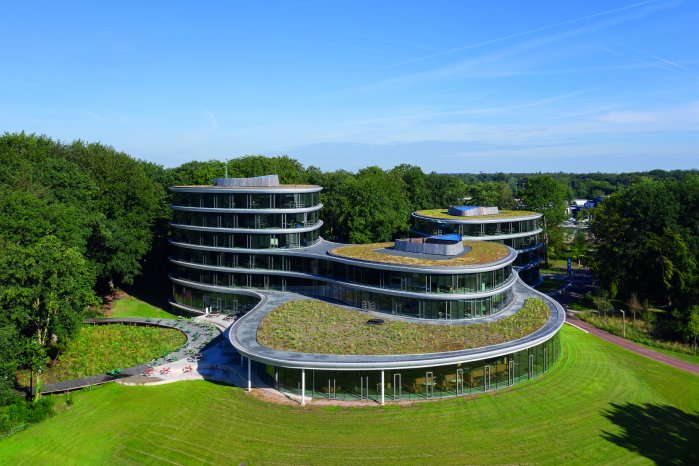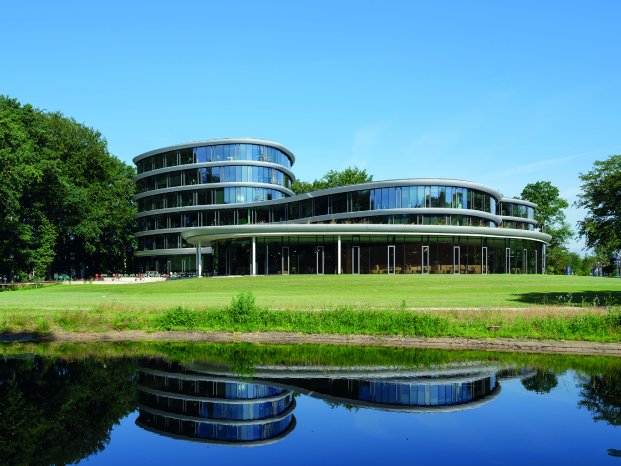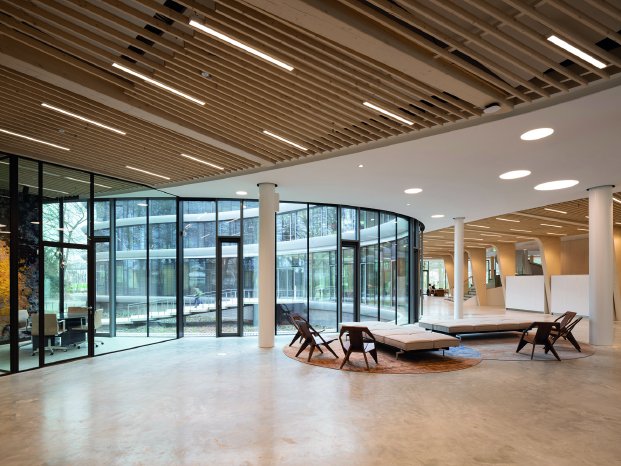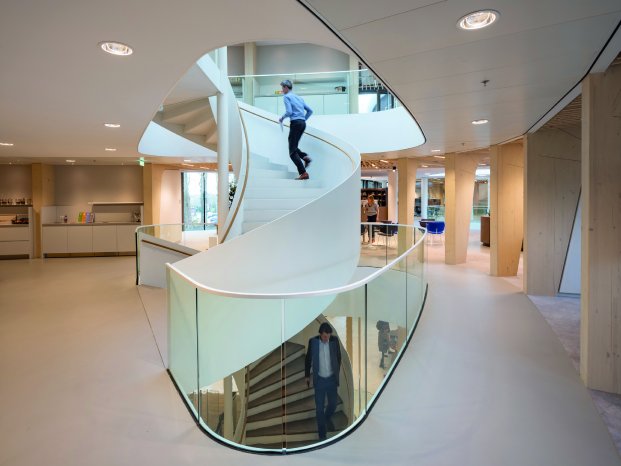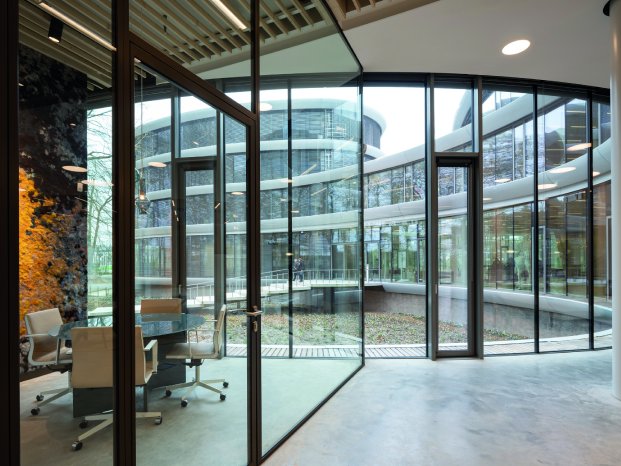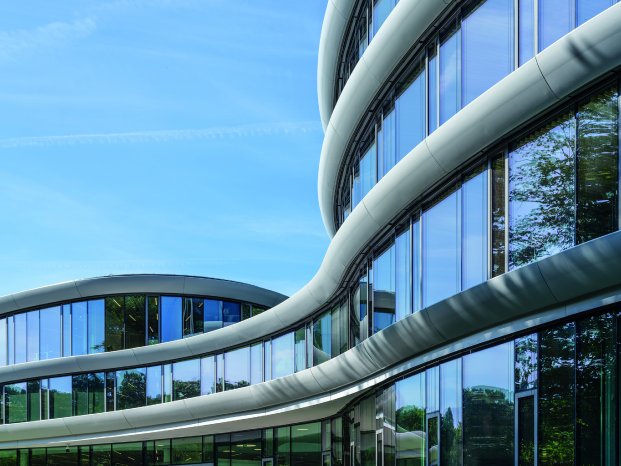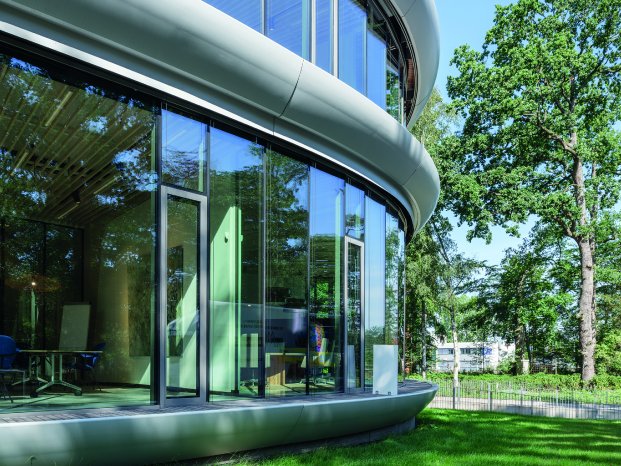It is commonly accepted that building on land results neither in greater biodiversity, nor in the creation of new habitats for animals. When the diggers move in, the plants and animals have to move out. Particularly in the densely populated Netherlands, competition for space is fierce and effective protection of the climate, nature, soil and water is extremely difficult. Completed in autumn 2019, the Triodos Bank office building on the De Reehorst estate in Driebergen-Rijsenburg, approximately 45 kilometres from Amsterdam, is a perfect example of how these aspects can be brought into harmony. The construction and design of the 13,000 m2 newbuild is based on the principles of nature and biomimicry, thereby imitating natural life. Stretching across three interconnected towers that are 3, 4 and 5 storeys high respectively, the complex blends into the landscape with its organic shapes, refined materials and natural colours. When it reaches the end of its lifecycle, its carbon footprint will be minimal. If the building needs to be dismantled and rebuilt, it can be quickly taken apart and screwed back together.
Driving force for a circular economy
The construction process for this architectural masterpiece was just as demanding as the concept was unusual. The integration of the newbuild into the landscape required a great deal of skilful planning to ensure it looked like part of the ecosystem rather than a foreign object that had fallen out of the sky. The project also required a brave client with a vision for the future and the patience of a saint. Triodos Bank had both. Efforts to find a suitable office building near Utrecht and Amersfoort to accommodate the growing staff numbers were in vain. In 2011, a decision was made to construct the new office building on the De Reehorst estate. The choice of location was in no way a last resort – this is the place where the Dutch bank was founded in 1980. It was crucial for the building to have a positive impact on people, nature and the environment. After all, the sustainable bank, which is active in 43 countries with assets totalling over 20 billion euros in 2020, only invests in projects with social, ecological and cultural added value. The newbuild therefore had to reflect this philosophy too. Ideally, a building would be created that would go far beyond the previous limits of sustainability and provide impetus for circular construction.
Beyond the status quo
As a pioneer of the circular economy and multi-award winning architect, Thomas Rau was the perfect fit for this project. Widely regarded internationally as a trailblazer for circular, climate-positive and innovative buildings, Rau, who is known for challenging the status quo and always looking for better solutions, designed the two headquarters of Triodos Bank in 1999 and 2006. The architect sees buildings as a “limited edition”, a combination of materials, products and components limited in time, with a documented identity. In 2017, he founded the charitable Madaster Foundation and launched the online platform of the same name for the creation of digital material passports for buildings. In addition to RAU Architects, the property developers EDGE Technologies, construction company J.P. van Eesteren, interior design company Ex Interiors and many other parties were involved in the building project.
The landscape defines the design
In order to integrate the building into the plot of the 30 hectare protected area in the most sensitive way possible, the landscape architects from Arcadis worked together with the building specialists from Copijn to develop a cautious landscape concept that would enhance the quality of the space that has been created over many years. For example, water sources for deer, badgers and foxes were added, and new passageways and greenery created extra places of retreat. Taking into account the flight paths of the bats, the landscape and building planners agreed that the height of the buildings should be kept below the height of the trees. They were also in agreement over the use of an insect-friendly green roof, with its additional insulating and cooling effect.
The façade as both a feature and stabilising element
Visionary Rau lent the building its spectacular character through the use of amorphous curves in the building structure with a fully glazed aluminium façade. The breathtaking design of the façade was brought into being by means of a special Schüco construction based on the AWS 75 BS.HI+ window system as an insert unit. The highly thermally insulated block window with a 75 mm basic depth has extremely slim outer frame profiles with concealed drainage and no visible vent contours. The system boasts Uf values of between 1.5 and 2.0 W/(m2K) and fulfils the highest requirements in terms of energy efficiency and architecture, while also offering maximum transparency. The version used here perfectly highlights the lightweight character of high-quality aluminium window constructions. Furthermore, aluminium has a number of other unmatched benefits: durability, stability, robustness and 100% recyclability.
The façade substructure took on an important stabilising function by supporting the load-bearing timber units. The passive house-certified Schüco AOC 50 add-on construction on steel (ST) with a 50 mm face width impressed here, both technically and in terms of design, with outstanding performance characteristics which combine energy-efficient construction, streamlined fabrication and reliable installation. A new insulating principle enabled a highly thermally insulated vertical façade to be constructed with a Uf value of no higher than 0.8 W/(m2K). It was possible to achieve the large pane dimensions with triple glazing by means of an innovative, patented screw guide which permits infill thicknesses of up to 63 mm and a maximum weight of 1500 kg. The sealing components without the use of sealant in the vertical façade proved to be instrumental in achieving a professional finish. In addition, the building authority-approved use of powder-actuated fastener technology for steel substructures enabled a shorter fabrication time compared to welding.
A cathedral-like feeling of space
In the interior, the natural authenticity of the materials is utterly captivating. The extremely high ceilings, the wooden rafters arranged in the shape of a mushroom surrounding the core, and the consistent use of timber for the floors, ceilings, columns and shafts creates a feeling of space as if you are in a “cathedral made from wood”. The building with its glazed aluminium façade made from 1280 individual panes enables the best possible use of natural light right through to the very depths of the space. Transparent dividing walls, which also help to reduce noise, provide perfect views of the landscape from almost every single one of the 1000 work stations. The storey-height windows in the 3.60 m tall façade modules are practical as they can be opened to allow for natural ventilation. A visual connection between the storeys is created through galleries which are accessed via the spiral staircases. Short distances encourage people to change their workplace from time to time or to meet a colleague for a coffee at the espresso bar on the first floor. In total, 1615 cubic metres of glued laminated timber and 1008 cubic metres of cross laminated timber as well as five whole tree trunks were used in the building which has been awarded the “Outstanding” BREEAM sustainability rating. The 2623 cubic metres of wood have absorbed more than 1.6 million kilograms of carbon and grow back in than 12 minutes. Instead of using conventional fixing materials, which would make dismantling and rebuilding by material type impossible, 165,312 wooden screws measuring between 240 and 500 mm long hold the construction together.
Electric cars as energy stores
As the façade could not be used for energy generation through PV modules and the roof area was designated as a paradise for insects, the engineers had to come up with an alternative place to accommodate the over 3000 m2 of PV modules that generate 506,000 kilowatt hours of solar energy per year for the energy-neutral operation of the building. Why not use the carport roof and include the electric cars parked there in the energy concept of the building as active energy stores via bidirectional charging bays? This idea became reality with the help of the innovative “We drive solar” project, which supports novel solutions for mobility and energy systems as part of “Horizon Europe”, the EU funding programme for research.
Material bank for the future
The project partners ventured into yet more unchartered territory with the creation of the BIM-based material passport, which contains information about the origin and recyclability of all the materials, products and components so that they can be easily reused in future. The planning process required for this was not carried out trade-by-trade as usual, but as part of an integrated collaboration. As everyone saw the building project as a learning process and focused on working as a team, they quickly got to grips with the procedure. The biggest hurdle was getting the IFC files (Industry Foundation Classes, an open file format used by Building Information Modelling programs) in the required quality from the suppliers, manufacturers and sub-contractors. The material values will be monitored in future by the abovementioned Madaster platform. The building is therefore not just a store of materials, but also a bank of materials, the value of which could be used as fixed assets, for example, or capitalised elsewhere.
Only time will tell if circular building can drive the digital transformation of the construction industry forwards. In any case, a new understanding of planning is essential. Furthermore, the circularity of buildings is likely to lead to interesting developments in terms of property valuation in the future. Consequently, the extended Triodos Bank office building could still provide impetus for breaking new ground.
Project details
Project: Triodos Bank, office building
Location: Driebergen-Rijsenburg
Country: The Netherlands
Design/construction period: 2011-2017
Gross floor space: 12,693 m²
Client: Triodos Bank, Driebergen, Rijsenburg, Netherlands
Architect: RAU Architects, Amsterdam
Interior design: Ex Interiors BV, Nieuwegein
Landscape architects: Arcadis Nederland BV, Amersfoort, Copijn, Utrecht
Façade manufacturer: Octatube, Delft and Lieftink, Geveltechniek, Alphen aan den Rijn
Project developer: EDGE Technologies, Amsterdam
Construction company: J.P. van Eesteren, Gouda
Building technology: Bosman Bedrijven, Amersfoort

